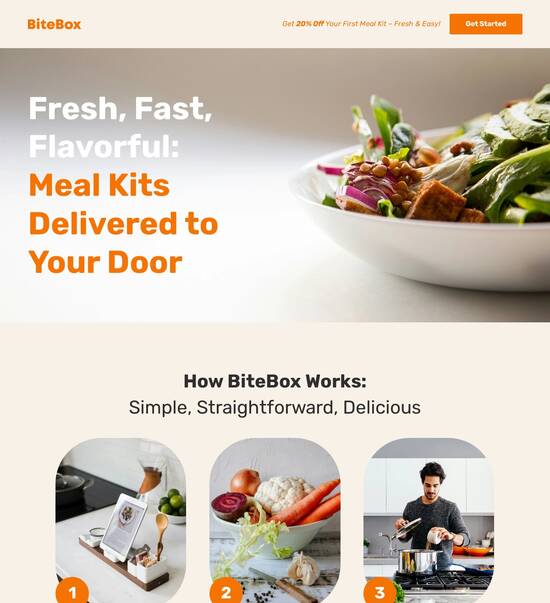
Website Template for Middle Schools
Explore Similar TemplatesAbout template
Create custom landing pages tailored for middle schools with our user-friendly template. Increase student engagement and parent involvement with our optimized layouts and easy-to-use design features.
Recommended templates

Easy to build without coding
With the intuitive drag-and-drop builder, anyone on your team can create high-converting pages without any knowledge of code or design. Make enhancements to your landing page with custom widgets using Javascript, HTML/CSS, or third-party scripts.

Multiple layouts for any industry and goal
Select from 500+ landing page layouts built to boost conversions across industry-specific scenarios. Customize them by adjusting fonts, adding images, and generating on-brand content with the AI assistant. Quickly scale with Instablocks® and Global Blocks that you can save, reuse, and update globally.

Loads fast and looks polished on any device
Every template is responsive, which means they present professionally on any device and load blazingly fast with our Thor Render Engine. You can also power them up with Google AMP technology to deliver an unparalleled mobile experience and drive higher conversions.

Robust analytics & experimentation
Get real-time updates and reporting across all your devices, showing the number of visitors, conversions, cost-per-visitor, and cost-per-lead. Launch AI-powered experiments, run A/B tests, and use heatmaps to analyze user behavior, then optimize your landing page to maximize conversions.







Easy to build without coding
With the intuitive drag-and-drop builder, anyone on your team can create high-converting pages without any knowledge of code or design. Make enhancements to your landing page with custom widgets using Javascript, HTML/CSS, or third-party scripts.
Multiple layouts for any industry and goal
Select from 500+ landing page layouts built to boost conversions across industry-specific scenarios. Customize them by adjusting fonts, adding images, and generating on-brand content with the AI assistant. Quickly scale with Instablocks® and Global Blocks that you can save, reuse, and update globally.
Loads fast and looks polished on any device
Every template is responsive, which means they present professionally on any device and load blazingly fast with our Thor Render Engine.
Robust analytics & experimentation
Get real-time updates and reporting across all your devices, showing the number of visitors, conversions, cost-per-visitor, and cost-per-lead. Launch AI-powered experiments, run A/B tests, and use heatmaps to analyze user behavior, then optimize your landing page to maximize conversions.
All the features you need to build middle school web design
Explore more featuresLearn how to build simple school website templates
Frequently asked questions about schools website templates
Leading the way in building high-performing landing pages





Website template for schools: Your ultimate how-to guide
With the increasing demand for effective marketing strategies, using Instapage’s cutting-edge landing page capabilities can immensely enhance your campaigns. This guide outlines the steps required to create impactful landing pages tailored to your audience, maximizing your conversion rate and return on investment (ROI).
Understanding the importance of high-converting landing pages
Landing pages serve as a digital touchpoint where visitors engage with your marketing efforts. A well-designed landing page can significantly boost conversion rates. By leveraging Instapage’s extensive library of over 100 templates, marketers can craft pages that are both visually appealing and functionally effective, tailored for business services, tech, education, and more.
- Conversion-focused design: Prioritize aesthetics with a simple layout that drives focus toward call-to-action elements.
- Targeted messaging: Align copy and imagery to resonate with specific audience segments for greater impact.
- Mobile optimization: Ensure your landing pages are mobile-friendly, catering to users on all devices.
Creating your first landing page
Follow these steps to build your landing page on Instapage, which offers a seamless experience even for those without coding skills.
- Choose a template: Browse the library and select a design that fits your campaign goals.
- Customize your content: Use drag-and-drop builders to add relevant images, videos, and text that speak to your target audience.
- Integrate lead generation elements: Include forms or call-to-action buttons that capture visitor information efficiently.
Optimizing landing pages for better performance
After creating your landing page, optimization is key to ensuring it meets performance standards.
- A/B testing: Conduct split tests to evaluate different elements, such as headlines or button colors, and monitor which variation results in higher conversions.
- Analytics review: Keep track of metrics through Instapage’s analytics dashboard to identify areas needing improvement.
- Implement heatmaps: Utilize heatmaps to visualize user interaction on your site, optimizing layout and content based on real user behavior.
By following these steps, you can create landing pages that not only attract traffic but convert visitors into leads effectively.
In conclusion, mastering landing page best practices can lead to a significant hike in your marketing effectiveness. Instapage equips you with the necessary tools to do just that.
Get started today with Instapage and watch your marketing campaigns reach new heights. Explore templates and collaboration features to transform your approach to digital marketing.
People also ask about school web page template
Website template for middle schools: Creating effective online spaces for education
The evolution of website templates in education: A historical perspective
Website templates for education have come a long way, evolving significantly over the years. The origins of educational websites can be traced back to when schools first started establishing an online presence. Between 2007 and 2015, many educational institutions transitioned from static HTML pages to more dynamic templates. This shift allowed for easier updates, real-time information dissemination, and improved interactivity.
The introduction of content management systems (CMS) has played a pivotal role in shaping middle school websites. The importance of user-friendly interfaces cannot be overstated; educators and administrators required tools that simplified website management. As a result, CMS platforms became popular, providing schools with customizable features that suited their unique educational needs.
Looking ahead, emerging trends between 2020 and 2025 indicate a strong focus on integrating interactive elements and adopting mobile-first design principles. Schools need to adapt to the changing landscape of technology, ensuring their websites remain relevant and engaging for both students and parents in today’s digital environment.
Why middle schools need specialized website templates
Middle schools face unique challenges in communication, making specialized website templates essential. Engaging both students and parents is crucial; these templates must cater to diverse audiences who seek different types of information. Communicating important announcements, updates, and school events needs to be clear and accessible to maximize engagement.
Accessibility enhancements in website templates are vital for engaging students with varying learning styles. This includes features such as interactive content, multimedia resources, and mobile responsiveness. By facilitating accessibility, schools can ensure that all students have equal opportunities to access information, thereby fostering an inclusive educational environment.
Furthermore, administrative and educational functions are supported through effective website templates. Tools that help maintain up-to-date information, integrate school calendars, and notify students and parents about events are critical. Websites that serve these functions not only simplify communication but also enhance the overall learning experience.
Key features of middle school website templates
User-friendly design templates are foundational to effective middle school websites. An intuitive interface ensures easy navigation, allowing users to find information quickly. Customization options are equally important; schools can incorporate their branding elements such as colors and logos, making their websites recognizable and relatable.
Pre-designed layouts that focus on educational needs, such as class pages, teacher profiles, resource libraries, and event sections, can significantly enhance usability. These layouts provide consistent structure across various pages, making it easier for visitors to find necessary information without confusion.
Another crucial feature is SEO-friendly structures that enhance online visibility. These include built-in tools that help optimize content for search engines and employ sitemaps for better discoverability. Coupled with accessibility features that comply with ADA and WCAG guidelines, these templates ensure a broad reach while catering to diverse user needs.
The role of CSS in customizing middle school websites
Cascading Style Sheets (CSS) play a significant role in web design, especially for educational websites. CSS allows for the styling of webpage elements, enhancing visual appeal and usability. By defining how HTML elements are displayed, CSS helps create intuitive designs that are consistent and professional.
Creating a unique school identity through custom styles is another important aspect. Utilizing school colors, logos, and specific educational themes helps reinforce brand identity while making the website visually engaging. Custom styles can be tailored to reflect the ethos of the school, resonating with the community it serves.
Responsive design is essential for adapting content to multiple devices. Ensuring that the website is accessible on tablets and smartphones expands its reach. The role of media queries in responsive layouts enables designers to create flexible and adaptable designs that maintain usability regardless of screen size.
Privacy and rights considerations for school websites
The protection of student data is paramount when designing middle school websites. Schools must be aware of privacy laws applicable to educational institutions to safeguard sensitive information. Establishing guidelines for data handling and information security is essential to maintaining trust within the school community.
User consent and rights management also require careful consideration. Addressing the rights of students and parents in digital spaces is critical for compliance and ethical web practices. Incorporating clear privacy policies and user agreements helps ensure transparency and fosters trust among users.
To establish trust through transparency, schools should ensure parental awareness about data usage and provide user-friendly privacy settings. By prioritizing privacy and data security, educational institutions can create a safe online environment for both students and their families.
The future of middle school websites: Trends beyond 2025
The integration of AI and automated features is poised to redefine the role of middle school websites. Innovations like chatbots can facilitate student engagement by providing immediate answers to common questions. Personalizing content delivery based on user preferences will further enhance the user experience.
There is also an increasing emphasis on interactive elements, such as gamification in educational websites. This approach not only makes learning fun but also enhances retention of information by engaging students in more dynamic ways. Support for multimedia content like videos and podcasts enriches educational resources available to students.
Finally, enhancing community building through online platforms is essential. Schools can encourage parent-teacher communications through discussion boards and forums, fostering a stronger school community. Utilizing these online tools will not only improve engagement but also strengthen relationships between families and the school.
Implementing effective sitemap and XML structures
A well-structured sitemap is crucial for maintaining user-friendly navigation on middle school websites. It aids in visual organization of content, making it easy for users to find what they are looking for. Effective sitemaps improve overall website functionality and enhance user satisfaction.
Utilizing XML sitemaps can further enhance website visibility on search engines. It provides search engines with a clear reference to all the pages included on a site. Strategies for creating effective XML structures include ensuring consistent updates and optimizing tags for accurate indexing.
Case studies: Successful middle school websites utilizing templates
Examining successful middle school websites can provide valuable insights into the effective use of templates. For instance, School A successfully overcame communication barriers by implementing a user-friendly website tailored to student and parent needs. Their site features easily accessible information and interactive elements that foster engagement.
School B showcased the use of interactive elements to enhance student engagement. By incorporating gamified learning experiences and multimedia content, they created a dynamic educational environment. Both schools demonstrate how customized website templates can be tailored to specific educational contexts and needs.
The key takeaways from these case studies underline the importance of understanding the target audience. By adapting website templates based on specific needs, schools can effectively communicate and engage with students and their families. This adaptability also reflects a commitment to improving the educational experience through innovative digital solutions.
Ready to skyrocket conversions?
Supercharge your ad campaigns with high-performing landing pages
Get started














